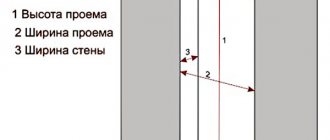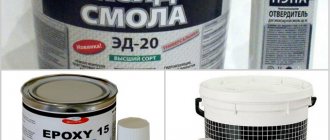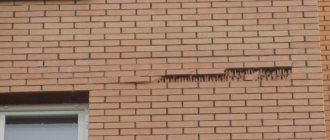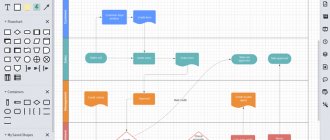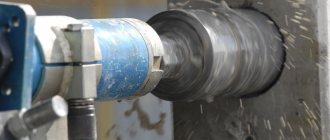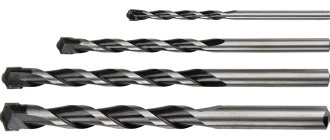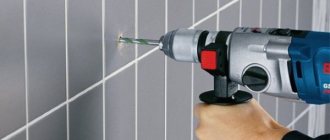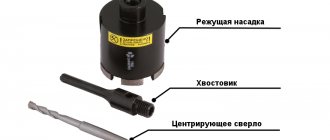Concrete is an excellent building material with high strength. Therefore, drilling holes in concrete structures is a rather labor-intensive process that requires special tools. Today, there are a huge number of types of tools designed for drilling holes of various diameters and lengths.
Areas of application for drilling tools
When carrying out modern repair and construction work, quite often there is a need to drill holes in concrete. For this purpose, there are various tools on the market that greatly facilitate the task. With this tool you can not only make a hole in a hard surface, but also perform the work very accurately, accurately and quickly.
All tools used for concrete are also suitable for softer building materials such as brick or wood concrete.
Drilling tools allow you to create holes during construction, renovation or major renovation of a building for:
- heating, water supply, ventilation, sewerage systems;
- installation of automatic fire extinguishing systems;
- laying electrical cables, Internet networks and other communications;
- anchor bolts and other fasteners;
- installation of railings on flights of stairs and landings;
- making niches in the walls for safes, furniture, etc.;
- drilling test cores in building structures;
- installation of equipment for swimming pools.
Some finishing work also requires drilling a large number of holes in a concrete wall , for example, installation of metal profiles and plasterboard boards in the manufacture of suspended ceilings. The difficulty of drilling concrete lies in the fact that this material has high strength and is not homogeneous in composition. It contains crushed stone and metal reinforcement, which significantly complicates the work. A tool with diamond cutting segments copes well with the task of drilling concrete with reinforcement.
Diamond drilling is a modern and effective method of drilling concrete and reinforced concrete, which allows you to obtain holes that exactly correspond to a given diameter and depth . It is also worth noting that the holes are perfectly smooth, literally polished, so they do not require any further finishing and can be immediately used for their intended purpose .
Diamond drilling is usually used by specialists who regularly engage in repair and construction work. They are well aware of all the nuances and advantages of diamond drilling technology.
Special devices
In specialized stores you can find for sale special annular drills with diamond coating at the end. They are used for drilling rigs, which are used to drill fairly large holes, the diameter of which can even reach twenty-five centimeters. I would like to point out right away that such devices are very expensive, so purchasing them for drilling walls at home is absolutely pointless.
In cases where during repair work the wall must be supplemented with an socket or switch, another variation of the tool is used. This is a crown that has metal soldering along the entire circumference of its cutting edge. The diameter of the crowns varies from thirty to one hundred and twenty millimeters, but the standard size is sixty-eight millimeters.
The fact is that a hole of this size needs to be drilled in the wall to install a switch or socket. If you continue to wonder about how to drill through concrete when using a crown, I will answer that a hammer drill that has its impact mode disabled is ideal for this mission. If the wall being treated is too thick, you can use special extension attachments.
The crown itself can act as an attachment, but for a drill. This type does not have soldering, but is covered over the entire area with a coating consisting of a tungsten carbide alloy. An additional advantage of this attachment is that there is no need to change tools in cases where it is necessary to drill a wall lined with ceramic tiles. The thing is that such a nozzle fits perfectly on both tiles and concrete.
Related article: Mop for cleaning the floor. Which one to choose
I want to note that this type of charging can only be used on those impact drill models with a power of at least a thousand watts.
Often, the work of a hammer drill is accompanied by the use of drills, the diameter of which can vary from four to eighty millimeters. Many modern craftsmen are faced with the question of how to choose the correct drill diameter.
You can avoid this situation without much difficulty, because in order not to think about how to drill concrete later, you can immediately purchase a set of special drills when purchasing a hammer drill. Naturally, really high-quality kits that allow you to easily drill concrete walls are quite expensive, so I advise you to purchase a drill as needed in accordance with the diameter of the dowels used.
Types of drilling tools
For drilling concrete, various attachments are used, differing in shape, size of the working part and type of shank. Drilling small diameter holes is done with drills and drills. In cases where large holes are required, carbide or diamond bits are used.
Concrete drill bits
A concrete drill is a cutting tool and is used to create holes of small diameter (maximum 16 mm). Any drill consists of a working part and a shank. The working part, in turn, is divided into a calibrating section and a cutting edge. The cutting edge ensures that the tool penetrates the material, and the calibrating section located behind it has special grooves to remove drilling products . It is this that determines the diameter of the future hole and the smoothness of its edges.
The shank serves to secure the drill in the equipment used. Drills for concrete are available with shanks of two modifications: for an impact drill and for a rotary hammer. The drill shank has the appearance of a solid cylinder. The shank of the hammer drill has longitudinal grooves that ensure tight fixation of the tool in the chuck.
There is a certain limitation: thin drills cannot be used to drill deep holes
A concrete drill, as a rule, has a tip in the shape of the letter T. The tip is made of pobedite, an alloy of cobalt and tungsten, which is not inferior in strength to diamond . Pobedite tips retain their edge sharpness for a long time and easily withstand overheating. The diameter and length of the drill are interrelated: the larger the diameter, the longer the drill. For example, a tool with a diameter of 10 mm can be 540 mm long, but a tool with a diameter of 6 mm can be only 150 mm.
When choosing a drill, you should pay attention to the uniformity of the color of the tool and the color itself. Based on this feature, it is determined what finishing treatment the drill was subjected to. The steel-gray tint of the nozzle indicates that this procedure did not take place. The black color of the drill means that hardening has been carried out with superheated steam. If the tool has a yellowish tint, this indicates that it has undergone a finishing treatment such as tempering to reduce the internal stresses of the steel. But the best performance characteristics are provided by drill bits coated with a thin layer of titanium nitride, which have a bright golden color.
Concrete drills
A drill with a drill can only cope with soft and cellular concrete. To drill reinforced concrete, a hammer drill and a special type of drill (impact drill), which is usually called a drill, are used . The choice of drill depends on the conditions of the work being carried out, the properties of the material, and the total power of the hammer drill. With their help, you can make holes with a diameter of 4-30 mm and a length of 50-1000 mm.
The difference between drills lies in the number of working edges and the form of their sharpening. To remove concrete dust and other drilling products from the hole being processed, a structural part of the drill, such as a spiral rod, is used. The steepness of its spiral affects the rotation speed of the drill and the final speed of the work being carried out. Inside the rods of some drills there are cavities into which dust is drawn in when the tool rotates, creating the effect of pumping out air.
Currently, the following types of drills are used for drilling concrete:
- screw The length of such drills is 100-1000 mm, so they can be used to make holes of considerable depth;
- spiral. Used for drilling large diameter holes;
- flat. Designed for drilling holes of small diameter and depth.
One of the main structural elements of a drill bit is its shank. For this reason, for a specific hammer drill model, drills with a strictly suitable shank configuration are used.
Drills for drilling concrete are available with shanks of the following modifications:
- SDS-plus with a diameter of 10 mm;
- SDS-top with a diameter of 14 mm;
- SDS-max with a diameter of 18 mm.
The protrusions and recesses on the drill shank serve to secure the drill in the hammer drill chuck and directly affect its rotation
When choosing a drill, you should pay attention to the shape of its cutting surface. The best option, but also the most expensive, would be a tool with self-sharpening cutting edges, and a more economical one - with a centering spike. A drill with a cutting head in the form of a centering spike will drill a hole so that its internal surfaces will not delaminate.
In addition to the head, the drills also differ in the type of soldering. The most common is pobedit soldering from compositions of varying strengths:
- soft will win is used for lightweight concrete;
- medium-strength will win used for processing heavy concrete;
- Victory high strength is used for especially strong concrete and granite.
Advantages of diamond tools
But any strength will not cope well with the processing of reinforced concrete. Therefore, diamond tools are now widely used to drill holes in this material, as well as in concrete of different strengths.
Diamond tools are chosen for such obvious advantages as:
- no restrictions on drilling material. Diamond tools can be used both for drilling concrete and for drilling the reinforcement present in it;
- no restrictions on the diameter and depth of holes;
- absence of vibrations that destroy the integrity of the treated surfaces;
- high precision of work performed.
For the production of tools, crumbs with diamond grain sizes of 150-500 microns are used. These can be natural diamonds, or rather, waste from the jewelry industry, which are distinguished by a wide range of hardness, size and shape. Synthetic diamonds are produced by heating carbon to very high temperatures and under great pressure. Tiny diamond grains obtained using this technology are in no way inferior to natural crystals, but their cost is an order of magnitude lower. Synthetic diamond chips are characterized by greater dimensional stability, purity and hardness , which ultimately provides increased wear resistance of cutting edges.
Diamond chips are mixed with metal powder. The resulting mass is formed into products of various shapes (diamond segments) using special presses. After this, the segments are sintered using powder metallurgy technology. The metal powder, after sintering, forms a so-called matrix designed to hold diamond grains.
Diamond segments are attached to the cutting tool base using:
- laser welding . Such a connection can withstand high temperatures, so a tool obtained using laser welding can be used for both dry and wet drilling of concrete;
- sintering (formation) of diamond segments directly on the edge of the tool body. Such a tool is also able to withstand high temperatures and can be used for both dry and wet methods of drilling holes in concrete;
- soldering with high temperature solder. The tool can withstand temperatures of no more than 600 degrees, so it can only be used for drilling with water. It should also be taken into account that for effective drilling with a diamond tool, it is necessary to comply with the condition of constantly removing sludge from the hole being drilled, and water washing is considered the most effective way to remove sludge. Tools made using this technology are most widely used in modern construction.
Soldering with high-temperature solder is today considered the most technologically advanced method of attaching diamond segments
The consumer properties of a diamond tool depend on both the characteristics of the diamond grains and the properties of the matrix. A necessary condition for maintaining the cutting properties of a drill or bit is constant wear of the matrix.
The wear rate of diamond segments should be:
- not very high, in order to eliminate the pointless waste of efficient micro-incisors;
- not very low so that the diamond grains can be opened in time as the micro-incisors chip away.
In other words, the optimal matrix hardness is selected depending on the material being processed. Diamond grains chip relatively quickly when processing hard materials such as granite or quartz . If new grains do not open in time, the diamond segment will become “salted.” For this reason, soft matrix tools made using bronze or tin powder are used for drilling hard materials.
When processing soft materials, such as limestone, the diamond grains wear out slowly. To prevent these grains from falling out of the matrix too quickly, powders from hard metal alloys, such as tungsten carbide, are used as a binder.
For drilling medium-hard materials (concrete screeds, reinforced concrete), segments with medium-hard matrices (cobalt, nickel, iron) are used..
As for diamond grains, the higher the hardness of the material being processed, the finer the grains should be and the higher their concentration. For processing soft materials, segments with larger diamond grains are used.
Concrete drill bits
Externally, the crown looks like a piece of steel pipe, in the walls of which holes are made to allow concrete chips and dust to escape during operation . One end of this pipe is capped with a flange (shank) for fastening the tool in the hammer drill chuck. The flange has special fixing grooves that comply with the SDS standard. At the other end of the pipe there are cutting teeth and a protruding centering drill, which fixes the position of the crown during drilling and prevents it from “walking” during rotation.
There are many types of concrete crowns. They differ depending on the diameters of the holes being drilled, the type of fastening in the chuck, and the hardness of the material being processed. Currently, crowns are produced in two main modifications - for impact and non-impact drilling modes.
Depending on the material of manufacture and design, crowns can be divided into:
- serrated bits for impact drilling;
- diamond bits for hammerless drilling;
- KS standard crowns with diamond coating.
The cutting edge of gear bits is formed by separately soldered teeth made of especially strong alloys
Serrated bits are designed for use with impact drills and rotary hammers . Their main disadvantage is the possibility of tooth destruction when meeting the reinforcement of concrete surfaces. Although the teeth themselves have a fairly high strength, which makes it quite possible to cut metal, the impact drilling mode creates unacceptable loads on the solder joint, which leads to their breakage. Therefore, such crowns can only be used for drilling in pure concrete or brick walls.
Diamond core bits are a more technologically advanced cutting tool and are used with rotary hammers and drills in hammerless drilling mode . They have a smooth cutting edge with small notches, made by spraying fine diamond or corundum sand.
The technology of non-impact drilling with a diamond core has a number of significant advantages compared to the impact method:
- reduced noise level during tool operation;
- less dust;
- absence of impact loads on the treated surface leading to the formation of cracks;
- high dimensional accuracy and quality of cuts of the drilled hole.
Diamond core bits easily cope with metal fittings. They have working diameters from 10 to 650 mm and allow you to drill holes up to 1.5 m deep. Bits with a diameter of up to 100 mm can be used with both professional equipment and household drills without the use of forced cooling. Large diameter crowns are used exclusively with professional drilling machines and with mandatory water cooling.
Crowns of the KS standard have a cutting edge with protruding segments with built-in diamond crystals. Crowns of this type successfully replace carbide gear bits. They are used for drilling holes in monoliths and slabs made of particularly strong grades of concrete. KS crowns have the longest service life.
The modern market is filled with crowns with various performance characteristics and advantages. The most popular tools are those produced under the brands Bosch, AEG, Cedima, Rothenberger, Tyrolit. Domestic manufacturers Adel, Alaton, Niborit, EuroPrice, Splitstone also offer high-quality products.
Features of using crowns for concrete
Serrated carbide bits are effective when paired with a hammer drill. Hammer drill chucks use the SDS fastening standard, which provides for the presence of special locking grooves in the drilling tool shanks . This fastening system allows you to easily and quickly change attachments without the use of clamping keys. In addition, it provides the tool with free movement along the drilling axis, which is necessary for the full release of impact energy into the surface being processed.
Diamond core bits require the use of rather complex technical devices that allow drilling to be carried out without shock or vibration.
The drilling rig is usually fixed in a certain way , which greatly facilitates the work of the operator, who does not need to hold the tool, but only move it in the required direction. This achieves very high quality and accuracy of holes.
When starting drilling, you should install the centering drill at the point corresponding to the center of the future hole. If the crown does not have a centering drill, then it is necessary to apply its cutting edge to the wall surface with all teeth simultaneously.
Excessive pressure should not be applied to the tool until the bit has penetrated enough into the concrete to stabilize the desired direction. To effectively remove dust, it is recommended to use a construction vacuum cleaner with a special hose attachment . The main feature of drilling with a crown is that it does not need to be periodically removed from the hole being machined for inspection or cooling, but can be continuously drilled to the required depth.
Best Diamond Drilling Rigs for 2021
Diamond drilling is used not only during large construction projects, but also during minor repairs in offices or buildings. As a rule, special diamond drills are used to make small-diameter holes. Drilling rigs are used for:
- Laying various engineering communications (communications, heating, plumbing);
- Installation of various fences, railings;
- Making ventilation holes.
Unlike light drills, the use of special installations allows you to perform work by making smooth holes of large diameter, both on a flat and on a curved surface.
When choosing such an installation, it is recommended to pay attention to the bed. After all, the full functioning of such a high-power unit is impossible without this element. The bed ensures that the machine is positioned in a certain position during drilling. If the installation begins to move during drilling, this can lead to jamming of the crown.
In powerful devices, the weight of the electric motor reaches 10 kg or more. Therefore, it is problematic to independently hold such a unit in one hand, and even when it is turned on. Therefore, to work with them, frame installations are used, which, according to the type of fastening, are anchor, vacuum and universal.
DIAM ML – 200A
This popular, according to buyers, inexpensive model of a diamond drilling rig belongs to the professional class of drilling equipment. This unit is designed for making holes in brick, reinforced concrete or monolithic concrete. It can also be used for drilling holes in blocks made of natural or artificial stone.
The weight of this power tool is 19 kg (the weight of the replacement tool is not included). During the work, it is permanently installed and secured with anchors. Thanks to the presence of replaceable diamond bits, this unit is capable of making holes with a diameter of 20 to 200 mm (brick, concrete). In reinforced concrete structures, this installation is capable of making holes with a diameter of no more than 180 mm.
During drilling, the water supply is connected to the installation, which is necessary to cool the device. The surface drilling angle of this model diamond machine ranges from 0 to 45 degrees. The device is equipped with only one speed, and is also additionally equipped with special electronic overload protection. The power level of the device is 2800 W. The maximum number of revolutions during idle is 617 rpm. in one minute.
DIAM ML – 200A
Advantages:
- Reasonable price, as for professional-type equipment (average cost is 51,500 rubles);
- Power;
- Availability of water cooling;
- Possibility of drilling at an angle.
Flaws:
- Heavy weight (19 kg);
- There is no speed control function (only one speed).
Rotorica Didri 330
Reliable, high-performance diamond drilling rig with a power of 3300 W. Equipped with 3-speed operating mode. The maximum hole diameter (when working with reinforced concrete surfaces) is 352 mm. Additionally, the unit is equipped with a special hand pump and water cooling. The weight of the device stand is 19 kg. The weight of the entire unit is 34.5 kg. Depending on the selected speed mode, the rotation speed of the device and the working stroke of the cartridge are 400, 800, 1200 revolutions per minute.
This unit is also equipped with a special indicator that allows you to control the oil level using laser positioning. For longer, more reliable operation, the device is equipped with overload protection.
Rotorica Didri 330
Advantages:
- Availability of 3 speed modes;
- Power;
- Torque (minimum 400, maximum – 1200 rpm);
- Functional;
- Availability of quick-change motor mount;
- Possibility of connecting water cooling;
- Equipment.
Flaws:
- Cost (125,000 rubles);
- Weight (34.5 kg).
Prodiamond PRO303EL – N
Designed for making holes in reinforced concrete, brick, stone and other surfaces. The unit can only be operated on a stand with a water cooling supply. This model is equipped with a 3-speed gearbox, which allows work to be carried out at an optimal level.
The engine of the device is equipped with a soft start system, and its body is made of aluminum. The gearbox of the device is made of high-strength steel. The installation power is 3420 W. The maximum drilling diameter is 300 mm. The maximum number of revolutions at idle (depending on the selected speed) is 380, 870, 1620 per minute. The weight of the device is 20 kg.
Prodiamond PRO303EL – N
Advantages:
- High power;
- Availability of three-speed gearbox;
- Availability of electronic and mechanical engine protection;
- Equipped with a soft start system.
Flaws:
- Do not perform work at an angle;
- High cost (153,630 rubles).
Messer KDM52D
The device is intended for making holes in reinforced concrete structures, as well as in concrete with a diameter of no more than 120 mm. A special feature of this device is that it is able to perform work without the supply of coolant. To do this, you need to connect a construction vacuum cleaner to the engine of the unit. To perform work without coolant, it is necessary to use special diamond bits.
This device is also capable of working with a connected pneumatic tank, which supplies coolant to the unit under pressure. The power of the device is 1800 W, and the maximum number of revolutions per minute is 3600. This tool is equipped with a two-speed operating mode, as well as an electronic overload protection function. The device stand is tiltable, allowing you to drill holes at the desired angle.
Messer KDM52D
Advantages:
- Possibility of drilling, both with and without coolant supply;
- Light weight (14 kg);
- Availability of two speeds;
- Cost (102,460 rubles).
Flaws:
- Low power;
- The maximum drilling diameter is only 120mm.
Equipment for drilling concrete and features of its use
Impact drills, rotary hammers, electric and hydraulic drilling machines are used for drilling concrete surfaces. Impact drills and hammer drills are used to drill holes with a diameter of up to 30 mm .
To create large holes, special drills are used, which are similar in appearance to a regular drill, but differ from it in some design features.
The main differences between drills and drills:
- the bormotor operates with the expectation of increased load torque, therefore it has increased power and reduced speed;
- The drill spindle has a hollow design that provides water supply to the drilling area.
For drilling with crowns with a diameter of up to 600 mm, electric boring machines are used . They are produced on the basis of very reliable and durable gearboxes and electric motors. Almost all electric motors have a safety clutch, electronic overload protection and starting current regulation. Bormotors with a powerful three-phase asynchronous motor also have a thermal switch built into the winding.
Some electric drills can be equipped with handles, which allows drilling to be done manually. But it must be remembered that this equipment creates a huge torque, so manual drilling can only be used for small holes and with great care . The slightest jamming of the tool threatens to dislocate the operator’s arm.
Drilling holes of large diameters creates such a high load torque on the spindle that it is impossible to hold the drill in your hands
Therefore, the drill bits are mounted on a frame with the ability to move in the direction of the axis of rotation of the drill bit. In most cases, the frame column can be inclined at an angle to the wall or to the floor. The tilt angle ranges from 0 to 45 degrees . The bormotor together with the frame make up the so-called drilling installation.
For drilling with crowns larger than 600 mm, hydraulic drills mounted on powerful frames are used. itself is small and light, but complete with the frame it is a heavy and bulky electro-hydraulic unit , which provides the necessary pressure and oil flow for the bormotor.
When preparing to drill concrete, you should choose the right drill bit, bormotor and bed. When choosing a nozzle, it is necessary to take into account not only its diameter, but also the material for which it is recommended. When selecting a frame and drilling machine, you should pay attention to the fact that equipment specifications usually indicate the maximum drilling diameter, calculated for soft materials. If you have to drill reinforced concrete, then it is better to choose a frame and drill with a “reserve”. Insufficient rigidity of the bed can cause vibration and, as a result, accelerated wear of equipment and tools .
The bed should be firmly fixed. The most reliable method of fixation is dowel fastening to the drilling surface . For this purpose, there is a special longitudinal groove in the bed platform. When choosing where to drill a hole for a dowel, it is necessary to take into account that the maximum rigidity of fixing the frame is ensured by the fastening located in the middle of this groove.
The second method of fixing the frame involves the use of a spacer fastening device , the length of which can be adjusted in the range of 1700-3100 mm. This device must be rested against the platform or inserted into the column of the frame. Then you should adjust the length of the fastening device until it touches the ceiling and firmly wedge it between the ceiling and the frame.
The third option for fixing the frame is vacuum fastening . In this case, the bed is equipped with a vacuum plate. A special pump is used to create a vacuum. This method of fixing equipment requires a perfectly smooth and even surface and, despite its convenience, is considered the least reliable.
After fixing the frame, a drilling tool is installed on it and the drilling attachment is secured. After assembling the installation, you should check the connections for play . It should be remembered that even the slightest play can cause the diamond segments to bend outward or inward of the crown (the so-called “tulip formation”).
Checking for the absence of play should be carried out before each drilling:
- if play is detected in fixing the frame, it is necessary to tighten the dowel fastening or re-adjust the length of the spacer device;
- if there is play in the frame carriage, the carriage guides must be adjusted;
- if there is any play in the bormotor spindle, preventive maintenance of the bormotor will be required;
- Play in the fastening of the drill bit can only appear if the bit is not screwed onto the spindle.
It is believed that the maximum drilling speed with minimal wear of the cutting tool can be achieved with an optimal linear speed of the segments within 3-6 m/s . When calculating bit rotation speed, a number of variables are taken into account, including the moment of inertia of the tool, the diameter and mass of the spindle, the distance from the center of the spindle to the center of mass of the bit, and much more.
Accurate calculation of the bit rotation speed allows you to avoid the self-oscillation mode of the drilling rig, increase the penetration speed, and increase the service life of the equipment
Therefore, when choosing the optimal speed, you should use the plate on the bormotor, which indicates the recommended range of drilling diameters for each of the gearbox gears.
Before starting drilling, it is necessary to ensure a water supply to the work area. If possible, the water supply should be uninterrupted. The flow of water from the water supply can be adjusted using a special handle on the drill. If there is no running water, you can use a special water tank with a pump and pressure gauge.
Water washes away sludge from the drilling area, “refreshes” the diamond segments, and prevents overheating of the cutting tool . When adjusting the water supply, follow the basic rule - the instrument should under no circumstances overheat until tarnish appears. Otherwise, the solder may melt, causing the diamond segments to detach from the nozzle body.
In this case, it is necessary to ensure that the sludge is completely washed out of the hole. If the water flows out slowly and does not carry the sludge with it, it is necessary to increase its flow rate . If the water in the tank runs out, drilling cannot be continued. Drilling without washing out the sludge will immediately become ineffective, and overheating of the working attachment will instantly melt the solder and render the tool unusable.
The bormotor should be turned on with the nozzle raised, and then drilled carefully and without much pressure until the cutting segments are completely hidden in the concrete. When inclined drilling, it is allowed to water the tool from the outside until it is completely drilled. If drilling is performed with a long bit of small diameter, then drilling into concrete is recommended to be done at low speeds.
When drilling in unreinforced concrete, very little force is required. Usually the bormotor’s own weight is enough for this . When drilling reinforced concrete, you should carefully increase the clamping force, while also increasing the water supply. While working, you must constantly listen to the sound of the operating machine. If you hear a characteristic clanging sound, which indicates the presence of a cut piece of reinforcement in the working area, you must stop the drill and remove the reinforcement from the hole being drilled. Re-drilling also begins with the crown fully raised.
Diamond segments can become “greasy” when drilling particularly strong concrete . This will be indicated by a noticeable decrease in penetration rate even with increased clamping force. In this case, the crown must be removed and the diamond grains “opened” by briefly drilling into an abrasive material, such as brick.
It should be borne in mind that the manufacturer, when producing diamond cutting segments, always tries to find a compromise between two opposites:
- increase processing speed;
- increase the resistance of diamond segments to wear.
The total penetration of crowns (resource) is a difficult value to predict. It depends on the drilling conditions and the strength of the material being processed. .
The average drilling speed is just over 2 m/hour
In any case, the penetration rate is more important than the total penetration length with one tool, since the total cost of drilling concrete is less dependent on the cost of the diamond tool. The main components of the cost of this work are wages for personnel, the cost of daily delivery of the drilling rig to the site, depreciation of equipment, etc.
When drilling, do not overload the drilling machine . The main reason for the increase in load torque on a cutting tool is the friction of the nozzle against the walls of the hole. If friction has increased as a result of the bed moving, it is necessary to turn off the unit, remove the attachment, securely fasten the bed and carefully drill into the concrete again. If the cause of friction is irregularities in the geometry of the nozzle, then it should be replaced.
If there is a need to drill holes whose depth exceeds the length of the crown, use extension rods . They can have a length of 200, 300, 400, 500 mm. The rods can be connected to each other to obtain the required drilling depth. After drilling is completed, the drill must be thoroughly cleaned and the threaded connections of the spindle and attachment lubricated.
Characteristics of drilling rigs
- Power indicator. This parameter affects the overall performance of the equipment and characterizes its capabilities. If we take a 1600 W installation as an example, then its drilling diameter will be 120 mm. For comparison, a device with 2700 W of power can drill a hole with a diameter of up to 350 mm.
- Number of speeds. Equipped with several speed modes allows you to set the desired mode, taking into account the hardness of the material and the diameter of the crown. Often drilling machines are equipped with 2-3 speeds. Cheaper analogs have only one speed.
- If there is an inclined stand, it is possible to drill at an angle. The most popular modifications allow you to drill holes at an angle of 30-150 degrees.
Security measures
When drilling into concrete, dangers arise from factors such as:
- working with power tools;
- the likelihood of damage to communications hidden inside the concrete surface;
- performing work at height.
Therefore, it is necessary to monitor the serviceability of the power tool used and prevent damage to the insulation of the power cable. When drilling holes at a height of more than 1.5 m from the floor level, the operator must be provided with a reliable and stable base .
Before starting drilling, you should always check walls and other surfaces for hidden electrical wiring and other communications.
When performing work, you should always remember the basic safety rules:
- while working, the operator must wear special clothing and shoes;
- the equipment must include goggles for eye protection and a respirator for respiratory protection;
- during work, you must carefully monitor the fastening of the diamond segments in the cutting attachments;
- Diamond drilling tools require careful handling. They should not be thrown or put too much pressure on them during operation;
- When drilling, pauses should be taken to protect the tool from overheating.
Drills and drills: differences
A shank with certain grooves is the visible and main difference between hammer drill bits and drill bits
To reliably fix the concrete drill in the hammer drill chuck, as well as to quickly replace it with the selected tool, the SDS fastening system (SDS), developed by Bosch specialists, is used.
Depending on the category of the hammer drill and the type of drill used, a fastening system of one of five types can be used to fix the latter.
This system is used to hold tools with a shank diameter of 10 mm (this shank has two grooves).
Kawabanga! Transportation of concrete according to GOST
This is the most popular category of fastening devices, also used to secure tools with a shank diameter of 10 mm in a hammer drill. The SDS-plus shank has not two, but four grooves, two of which are closed.
This is a not very common category of fastening systems used to secure tools whose shank has a diameter of 14 mm. Devices of this type are used to complete rotary hammers of medium weight category.
Such devices are used to complete powerful rotary hammers of the professional series. They are equipped with drills with a shank diameter of 18 mm.
This not very common category of fastening systems is notable for the fact that on the shank of the tools for which it is intended to secure, there are not grooves, but protrusions.
This type of shank was used in Bosch Uneo rotary hammers
When deciding which drills are best for equipping a rotary hammer, you must first focus on the tasks that you are going to solve. According to this, you can choose a drill:
- for drilling holes of small diameter (its cutting edges are slightly rounded, which makes it possible to give it higher strength);
- crown type, with the help of which large-diameter holes are created (for example, a diamond drill).
Adapters are used to install a drill with a non-native shank into a hammer drill.
Price
Tools for drilling concrete are presented on the modern market by both foreign and domestic manufacturers. Therefore, it should be understood that the higher cost of products from a well-known manufacturer guarantees high quality tools and a long service life.
Among foreign manufacturers offering very high quality concrete drilling tools, we should highlight Bosch, Metabo, Makita, FIT, Stayer . Among the cheaper domestically produced tools, brands such as Adel, Interskol, Enkor, Zubr, and Europrice have proven themselves well.
The cost of a concrete tool often depends on the brand's popularity
When choosing a tool, you should keep in mind that high-quality attachments cannot be too cheap, since only the best materials and innovative technologies are used for their manufacture.
Average cost of diamond core bits of standard length 450 mm:
| Crown diameter, mm | Number of segments | Cost, rub |
| 46 | 5 | 4700 |
| 76 | 7 | 6300 |
| 112 | 9 | 8800 |
| 152 | 12 | 11700 |
| 202 | 14 | 15200 |
| 320 | 24 | 25000 |
| 600 | 32 | 46000 |
How does the equipment for diamond drilling of concrete work?
Our company uses modern equipment from leading manufacturers, which demonstrates high efficiency in the most difficult conditions. Thanks to the interchangeable bits, it is suitable for cutting both small openings and holes with a diameter of more than 100 centimeters. The design of a standard installation includes the following elements:
- bed;
- cooling system operating on the basis of running water;
- Electrical engine;
- directly to the diamond bit.
It is the crown that is the key part of the entire system. It is a cylindrical metal pipe on which teeth made of an alloy of increased hardness with diamond inclusions are placed. Rotating at high speed, the crown gradually cuts into the material and literally grinds it, turning it into the smallest dust. The waste material is washed off with water and collected with special construction vacuum cleaners. The water also cools the crown, preventing possible damage.
There are three main types of diamond bits:
- Screw. They are used for processing lightweight structures, self-sharpen during use, and remove sludge well.
- Spiral. They have the largest diameter, therefore they are most often used for installation of ventilation systems. Can also be used to dismantle walls of medium thickness.
- Gentle. They have the longest service life and are designed for drilling relatively shallow holes.
In a minute, the diamond crown penetrates the wall to a depth of 2 to 6 centimeters. Consequently, in order to cut through a standard ceiling in an apartment building, it usually takes no more than 20 minutes. At the same time, we also have more powerful equipment at our disposal, capable of making openings in reinforced concrete with a depth of up to 10 meters and a diameter of up to 500 millimeters. It is also important to remember that diamond drilling tools for reinforced concrete can be placed at any angle to the surface, not just perpendicular. In modern installations, a special hinge for inclined drilling is responsible for this.
conclusions
Modern cutting tools allow you to drill holes in concrete of almost any diameter and depth. With the help of such a tool, you can easily break through the most durable concrete surface. To drill small holes, you can use a drill or auger . A more difficult task is drilling large diameter holes. In this case, the best option is to use a tool with diamond segments. The main advantage of such a tool is high wear resistance.
Before starting work, you should always carefully study the characteristics and features of the material in which you plan to drill a hole, as well as the characteristics of the tool used. Based on the required dimensions of the future hole and the presence of reinforcement in the concrete surface, a drilling method is chosen. Without a preliminary analysis of the conditions of the work being carried out, it is impossible to drill holes in concrete accurately and accurately.
The practical side of choosing concrete drills is shown in the video:
Tips for drilling concrete
Before drilling, it is necessary to carry out some manipulations with the tool. I advise you to carefully check the drill chuck for contamination, which, if detected, must be removed as soon as possible using a piece of dry rag.
If you neglect this condition, then while you are drilling, various problems with the serviceability of the tool may arise. When inserting a drill into the chuck, make sure that it enters at a right angle and that the shank rests against the bottom of the chuck, otherwise the wall will remain untouched.
Indeed, the most serious problem that a concrete wall can present is the presence of metal reinforcement on the wall. Most often, such situations occur when concrete is drilled to a great depth. In this case, the reinforcement is processed with a punch, after which you can continue drilling.
Another option for solving this problem, when, for example, a concrete floor is covered with metal reinforcement, is to use a metal drill, which can easily be added to any impact drill.
Due to the fact that it is impossible to drill for longer than fifteen minutes using the tool used at home, you must take a break of the same duration every quarter of an hour. During this break, both the concrete and the tool used are cooled. One of the features of starting a tool to work on a concrete fault after such a break is treating the drill with water. For example, a screwdriver with a drill moistened with water is guaranteed to last longer, having completed a huge number of work tasks.
Related article: Do-it-yourself artificial snow
Often, during the drilling process, the wall begins to crumble on the other side. Simply put, the concrete layer separates the plaster layer from itself. Such processes should be avoided at all costs, as they can lead to the concrete layer being damaged and the process of its destruction beginning.
To preserve concrete in its original form, you only need to slightly slow down the speed of the tool, thereby reducing the intensity of its impact on the wall. This precaution ensures that the concrete layer of the wall remains intact.
Another trouble that happens when a drill is processing a concrete layer of a wall is the drill getting stuck. Under no circumstances try to remove it by actively loosening the tool in the wall. Not only will this cause the concrete layer of the wall to collapse, but the tip, the upper part of the tool, may also break off.
The equipment must be disconnected as carefully as possible, replace the drill with a smaller one and begin drilling the concrete around the stuck one. This procedure may take a long time, but it will preserve not only the integrity of the wall and the functionality of the stuck drill after it is removed.
So, in our article we looked in detail at how to drill a concrete wall. With the right selection of tools and functional components for them, you can easily make holes in concrete. Moreover, this work will be done with the highest quality, without extra costs and very quickly.
What are crowns needed for?
The table below contains types of crowns according to various criteria.
Kawabanga! Chisels for concrete hammer drill
| Varieties of nozzles according to different separation criteria | |||||||
| edge material | way of working | tail type | cutting method | ||||
| diamond | victorious | drums | unstressed | SDS-max | SDS-plus | to "dry" | with water cooling |
There are models with a steel cutting edge and tungsten carbide.
Diamond bits allow you to perform work on reinforced concrete and concrete, but are expensive. They have a diameter of 25 to 130 mm and are used mainly by professionals.
Pobedite crowns have a lower price, but they do not use reinforced walls. Their diameter ranges from 35 to 120 mm.
Impact attachments are designed to be used when the hammer drill operates in impact-rotational mode. They are used to drill hard materials, non-reinforced walls or ceilings. In the non-impact drilling method, diamond bits are often used.
A number of models of crown bits have a drill located strictly in the center, extending beyond the working plane - this design feature helps to accurately drill according to the markings. The central drill acts as a guide.
